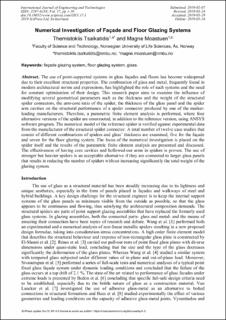| dc.contributor.author | Tsalkatidis, Themistoklis | |
| dc.contributor.author | Moastuen, Magne | |
| dc.date.accessioned | 2020-10-09T13:08:45Z | |
| dc.date.available | 2020-10-09T13:08:45Z | |
| dc.date.created | 2019-05-20T13:42:00Z | |
| dc.date.issued | 2019 | |
| dc.identifier.citation | International Journal of Engineering and Technologies. 2019, 17 1-10. | en_US |
| dc.identifier.uri | https://hdl.handle.net/11250/2682068 | |
| dc.description.abstract | The use of point-supported systems in glass façades and floors has become widespread due to their excellent structural properties. The combination of glass and metal, frequently found in modern architectural norms and expressions, has highlighted the role of such systems and the need for constant optimization of their design. This research paper aims to examine the influence of modifying several geometrical parameters such as the thickness and the weight of the structural spider connectors, the arm-core ratio of the spider, the thickness of the glass panel and the spider arm cavities on the structural performance of a spider connector produced by one of the marketleading manufacturers. Therefore, a parametric finite element analysis is performed, where four alternative versions of the spider are constructed, in addition to the reference version, using ANSYS software program. The numerical model of the reference spider is verified against experimental data from the manufacturer of the structural spider connector. A total number of twelve case studies that consist of different combinations of spiders and glass’ thickness are examined, five for the façade and seven for the floor glazing system. The focus of the numerical investigation is placed on the spider itself and the results of the parametric finite element analysis are presented and discussed. The effectiveness of having core cavities and hollowed-out arms in spiders is proven. The use of stronger but heavier spiders is an acceptable alternative if they are connected to larger glass panels that results in reducing the number of spiders without increasing significantly the total weight of the glazing system. | en_US |
| dc.language.iso | eng | en_US |
| dc.rights | Navngivelse 4.0 Internasjonal | * |
| dc.rights.uri | http://creativecommons.org/licenses/by/4.0/deed.no | * |
| dc.title | Numerical Investigation of Façade and Floor Glazing Systems | en_US |
| dc.type | Peer reviewed | en_US |
| dc.type | Journal article | en_US |
| dc.description.version | publishedVersion | en_US |
| dc.source.pagenumber | 1-10 | en_US |
| dc.source.volume | 17 | en_US |
| dc.source.journal | International Journal of Engineering and Technologies | en_US |
| dc.identifier.doi | https://doi.org/10.18052/www.scipress.com/IJET.17.1 | |
| dc.identifier.cristin | 1698807 | |
| cristin.unitcode | 192,15,0,0 | |
| cristin.unitname | Realfag og teknologi | |
| cristin.ispublished | true | |
| cristin.fulltext | original | |
| cristin.qualitycode | 1 | |

